weight MERCEDES-BENZ CLA 2018 Owners Manual
[x] Cancel search | Manufacturer: MERCEDES-BENZ, Model Year: 2018, Model line: CLA, Model: MERCEDES-BENZ CLA 2018Pages: 326, PDF Size: 7.97 MB
Page 21 of 326
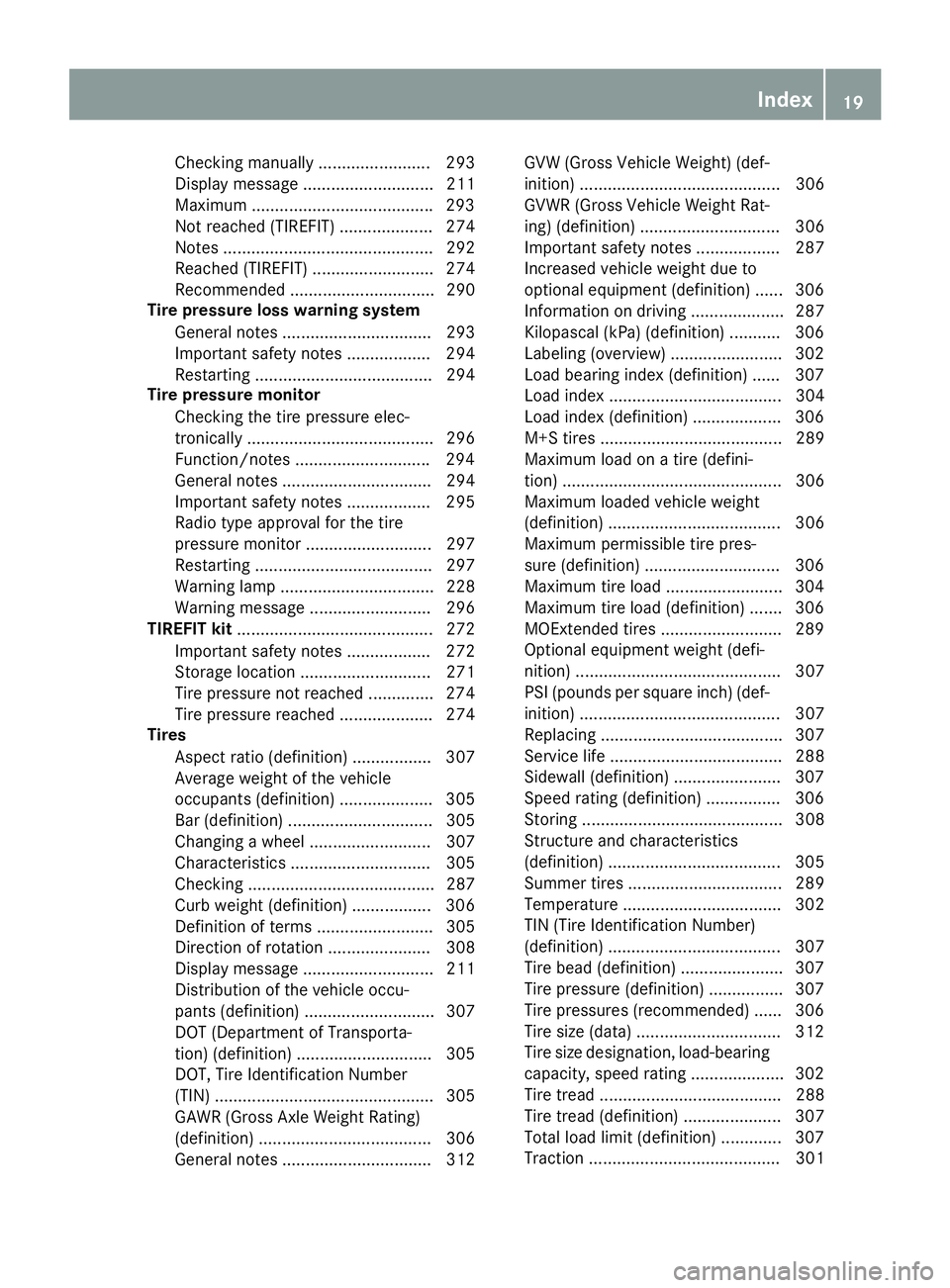
Checkin gm anually ........................ 293
Dis play message ............................ 211
Maximum ...................................... .2 93
Not reached (TIREFIT) .................... 274
Notes ............................................. 292
Reached (TIREFIT) .......................... 274
Recommended ............................... 290
Tire pressure los sw arning system
General notes ................................ 293
Important safety notes .................. 294
Restarting ...................................... 294
Tire pressure monitor
Checking the tire pressure elec-
tronically ........................................ 296
Function/notes ............................ .2 94
General notes ................................ 294
Important safety notes .................. 295
Radio type approval for the tire
pressure monitor ........................... 297
Restarting ...................................... 297
Warning lamp ................................. 228
Warning message .......................... 296
TIREFIT kit .......................................... 272
Important safety notes .................. 272
Storage location ............................ 271
Tire pressure not reached .............. 274
Tire pressure reached .................... 274
Tires
Aspect ratio (definition) ................. 307
Averag ew eight of the vehicle
occupants (definition) .................... 305
Bar (definition) ............................... 305
Changing aw heel .......................... 307
Characteristics .............................. 305
Checking ........................................ 287
Curb weight (definition) ................. 306
Definition of terms ......................... 305
Direction of rotatio n. ..................... 308
Displa ym essage ............................ 211
Distribution of the vehicl eo ccu-
pants (definition) ............................ 307
DOT (Department of Transporta-
tion) (definition) ............................. 305
DOT, T ire Identification Number
(
TIN) ............................................... 305
GAW R( Gr os sA xle Weight Rating)
(definition) ..................................... 306
Genera ln otes ................................ 312 GV W( Gr os sV ehicl eW eight) (def-
inition) ........................................... 306
GVWR (Gros sV ehicl eW eight Rat-
ing )( de finition) .............................. 306
Important safety notes .................. 287
Increased vehicl ew eigh td ue to
optiona le quipment (definition) ...... 306
Information on driving .................... 287
Kilopasca l( kPa )( de finition) ........... 306
Labeling (overview) ........................ 302
Loa db ea ring index (definition) ...... 307
Loa di ndex ..................................... 304
Loa di ndex (definition) ................... 306
M+S tire s. ...................................... 289
Maximu ml oa dona tire (defini-
tion) ............................................... 306
Maximu ml oaded vehicl ew eigh t
(definition) ..................................... 306
Maximu mp er missibl et ire pres-
sure (definition) ............................. 306
Maximu mt ire load ......................... 304
Maximu mt ire load (definition) ....... 306
MOExtended tire s. ......................... 289
Optiona le quipment weight (defi-
nition) ............................................ 307
PSI (pounds pe rs quare inch )( de f-
inition) ........................................... 307
Replacing ....................................... 307
Service life ..................................... 288
Sidewal l( de finition) ....................... 307
Speed rating (definition) ................ 306
Storing ........................................... 308
Structure and characteristics
(definition) ..................................... 305
Summer tire s. ................................ 289
Temperature .................................. 302
TIN (Tire Identification Number)
(definition) ..................................... 307
Tire bead (definition) ...................... 307
Tire pressure (definition) ................ 307
Tire pressures (recommended ). ..... 306
Tire size (data ). .............................. 312
Tire size designation, load-beari ng
ca p
acity, speed rating .................... 302
Tire trea d. ...................................... 288
Tire trea d( de finition) ..................... 307
Tota ll oa dl im it (definition) ............. 307
Tractio n. ........................................ 301 Index 19
Page 26 of 326
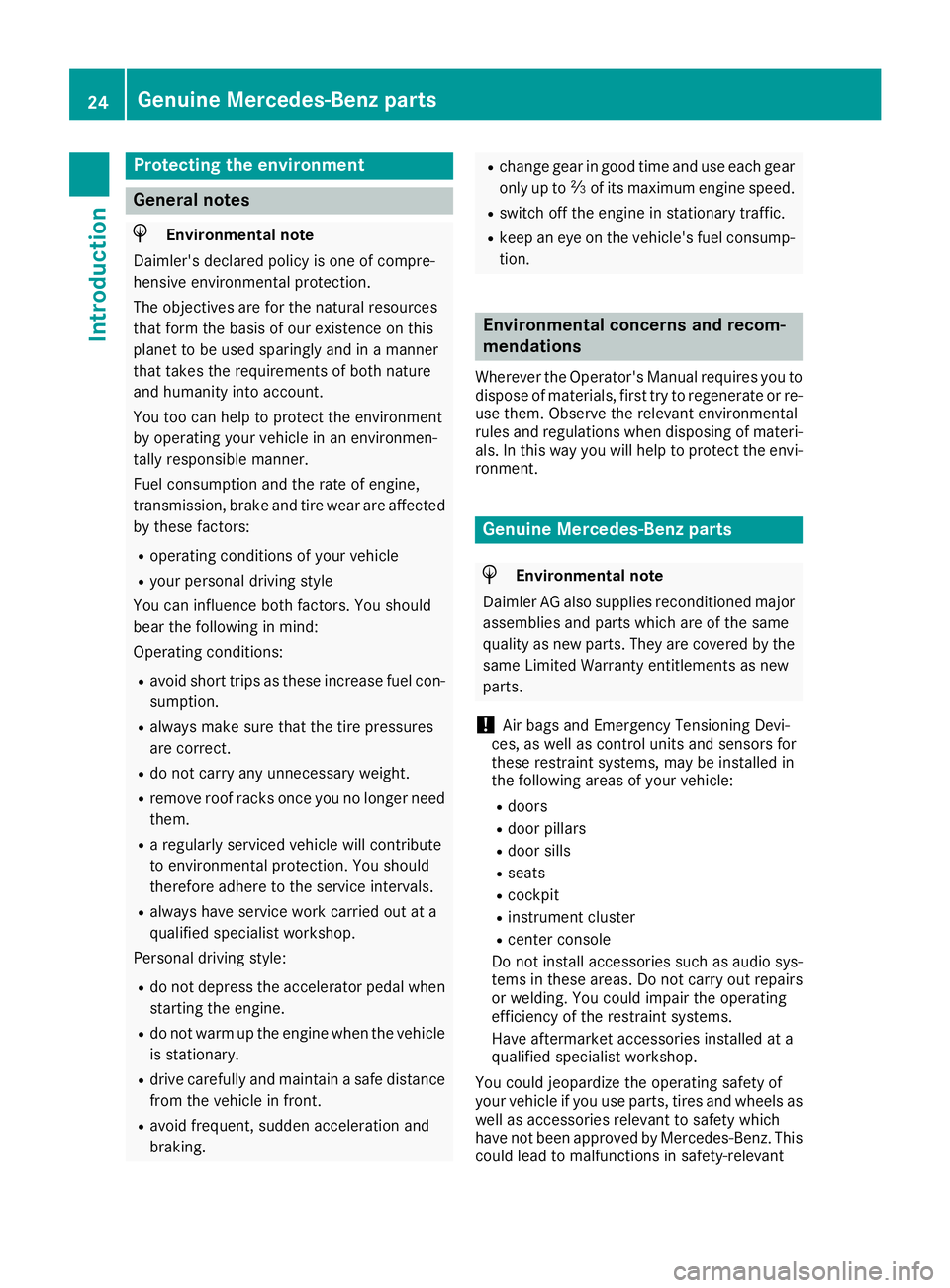
Protecting the environment
General notes
H Environmental note
Daimler's declared policy is one of compre-
hensive environmental protection.
The objectives are for the natural resources
that form the basis of our existence on this
planet to be used sparingly and in am anner
that takes the requirements of both nature
and humanity into account.
You too can help to protect the environment
by operating your vehicle in an environmen-
tally responsible manner.
Fuel consumption and the rate of engine,
transmission, brake and tire wear are affected
by these factors: R
operating condition sofy our vehicleR
your personal driving style
You can influence both factors. You should
bear the following in mind:
Operating conditions: R
avoid short trips as these increase fuel con-
sumption. R
always make sure that the tire pressures
are correct. R
do not carry any unnecessary weight. R
remove roof racks once you no longer need
them. R
ar egularly serviced vehicle will contribute
to environmental protection. You should
therefore adhere to the service intervals. R
always have service work carried out at a
qualified specialist workshop.
Personal driving style: R
do not depress the accelerator pedal when
startin gt he engine.R
do not warm up the engine when the vehicle
is stationary. R
drive carefully and maintain as afe distance
from the vehicle in front. R
avoid frequent, sudden acceleration and
braking. R
change gear in good time and use each gear
only up to �
Page 45 of 326

If ac hild younger than twelve years old and
under 5ft( 1.5 0m)inh eight is travelin gint he
vehicle: R
always secur et he child in ac hild restraint
system suitable for this Mercedes-Ben zv ehi-
cle. The child restraint system must be appro-
priat etot he age, weight and size of the childR
always observe the instructions and safety
notes on "Children in the vehicle"
( Y
page 54) in addition to the child restraint
system manufacturer' si nstallation and oper-
atin gi nstructionsR
always observe the instructions and safety
notes on the "Occupant classification system
(OCS)" ( Y
page 47)
G WARNING
The seat belts may not perform their intended
protective function if: R
the ya re damaged, modified, extremely
dirty, bleache dord yedR
the seat belt buckle is damaged or
extremely dirty R
the Emergency Tensionin gD evices, belt
anchorage sori nertia reels have been modi-
fied.
Seat belts may be damaged in an accident,
althoug ht he damage may not be visible, e.g.
due to splinters of glass. Modifie dord amaged
seat belts may tear or fail, e.g. in an accident.
Modifie dE me rgency Tensionin gD evices
could accidentally trigger or fail to deploy
when necessary. This poses an increased risk
of injury or even fatal injury.
Never modif yt he seat belts ,E me rgency Ten-
sioning Devices, belt anchorage sa nd inertia
reels. Make sure that the seat belts are
undamaged, not worn out and clean .F ollow-
ing an accident ,h ave the seat belts checked
immediately at aq ualified specialist work-
shop.
Only use seat belts that have been approved for
your vehicle by Mercedes-Benz.
Sports seat or AMG Performance seat: this
seat is designed for the standard three-point
seat belt. If you install another multi-point seat
belt, e.g. sport or racin gs eat belts ,t he restraint system cannot provide the best level of protec-
tion.
G WARNING
If you feed seat belts through the opening in
the seat backrest ,t he seat backrest may be
damaged or may even break in the even tofa n
accident .T his poses an increased risk of
injury or even fatal injury.
Only use the standard three-point seat belt.
Never modif yt he seat belt system.
Proper use of th es eat beltsObserve the safet yn otes on the seat belt
( Y
page 42).
All vehicle occupant sm ust be wearin gt he seat
belt correctly befor eb eginnin gt he journey. Also
make sure that all vehicle occupant sa re always
wearing the seat belt correctly while the vehicle
is in motion.
When fastenin gt he seat belt, always make sure
that: R
the seat belt buckle tongue is inserted only
int ot he belt buckle belonging to that seat R
the seat belt is pulled tigh ta cross your body
Avoid wearing bulky clothing ,e .g. aw inter
coat. R
the seat belt is not twisted
Only the nc an the forces which occur be dis-
tributed over the area of the belt. R
the shoulder section of the belt is routed
across the center of your shoulder
The shoulder section of the seat belt should
not touc hy our nec korber outed under your
arm or behin dy our back .W here possible,
adjust the seat belt to the appropriate height. R
the lap belt is taut and passes across your lap
as low down as possible
The lap belt must always be routed across
your hip joints and not across your abdomen.
This applies particularly to pregnant women.
If necessary, push the lap belt down to your
hip join ta nd pull it tigh tu sing the shoulder
section of the belt. R
the seat belt is not routed across sharp, poin-
ted or fragile objects
If you have such item sl ocated on or in your
clothing ,e .g. pens ,k eys or eyeglasses ,s tore
these in as uitable place. R
only one perso nisu sing as eat beltOccupant safety 43
Safety Z
Page 48 of 326
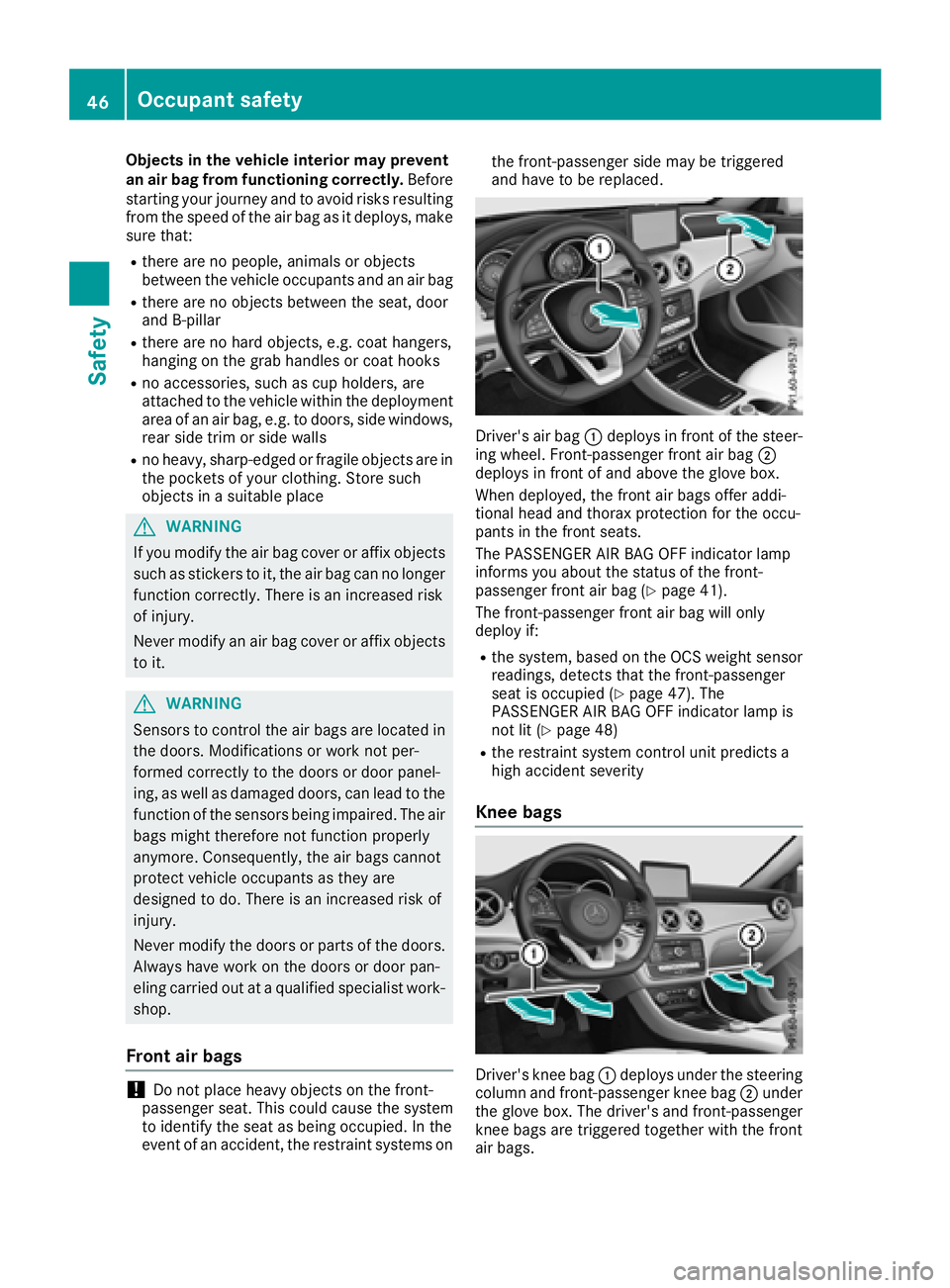
Objects in the vehicle interior may prevent
an air bag from functioning correctly. Before
starting your journey and to avoid risks resulting
from the speed of the air bag as it deploys, make
sure that: R
there are no people, animals or objects
between the vehicle occupant sa nd an air bagR
there are no object sb etween the seat, door
and B-pillar R
there are no hard objects, e.g. coat hangers,
hanging on the grab handles or coat hooks R
no accessories, such as cup holders, are
attached to the vehicle within the deployment
area of an air bag, e.g. to doors, side windows,
rear side trim or side walls R
no heavy, sharp-edged or fragile object sa re in
the pocket sofy our clothing. Store such
object sinas uitable place
G WARNING
If you modify the air bag cover or affix objects
such as stickers to it, the air bag can no longer
function correctly. There is an increased risk
of injury.
Never modify an air bag cover or affix objects
to it.
G WARNING
Sensors to control the air bags are located in
the doors. Modification sorw ork not per-
formed correctly to the doors or door panel-
ing, as well as damaged doors, can lead to the
function of the sensor sb eing impaired. The air
bags might therefore not function properly
anymore. Consequently, the air bags cannot
protec tv ehicle occupant sast hey are
designed to do. There is an increased risk of
injury.
Never modify the doors or parts of the doors.
Always have work on the doors or door pan-
eling carried out at aq ualified specialist work-
shop.
Front air bags
! Do not place heavy object sont he front-
passenger seat. This could cause the system
to identif yt he seat as being occupied. In the
event of an accident ,t he restraint systems on the front-passenger side may be triggered
and have to be replaced.
Driver's air bag �C deploys in fron toft he steer-
ing wheel. Front-passenger fron ta ir bag �D
deploys in fron tofa nd above the glove box.
When deployed, the fron ta ir bags offer addi-
tional head and thorax protection for the occu-
pants in the fron ts eats.
The PASSENGER AIR BAG OFF indicato rl amp
inform sy ou about the status of the front-
passenger fron ta ir bag ( Y
page 41).
The front-passenger fron ta ir bag will only
deploy if: R
the system, based on the OCS weight sensor
readings, detect st hat the front-passenger
seat is occupied ( Y
page 47). The
PASSENGER AIR BAG OFF indicato rl amp is
not lit ( Y
page 48) R
the restraint system control unit predict sa
high accident severity
Knee bags
Driver's knee bag �C deploys under the steering
column and front-passenger knee bag �D under
the glove box. The driver's and front-passenger
knee bags are triggered together with the front
air bags.46
Occupant safety
Safety
Page 54 of 326
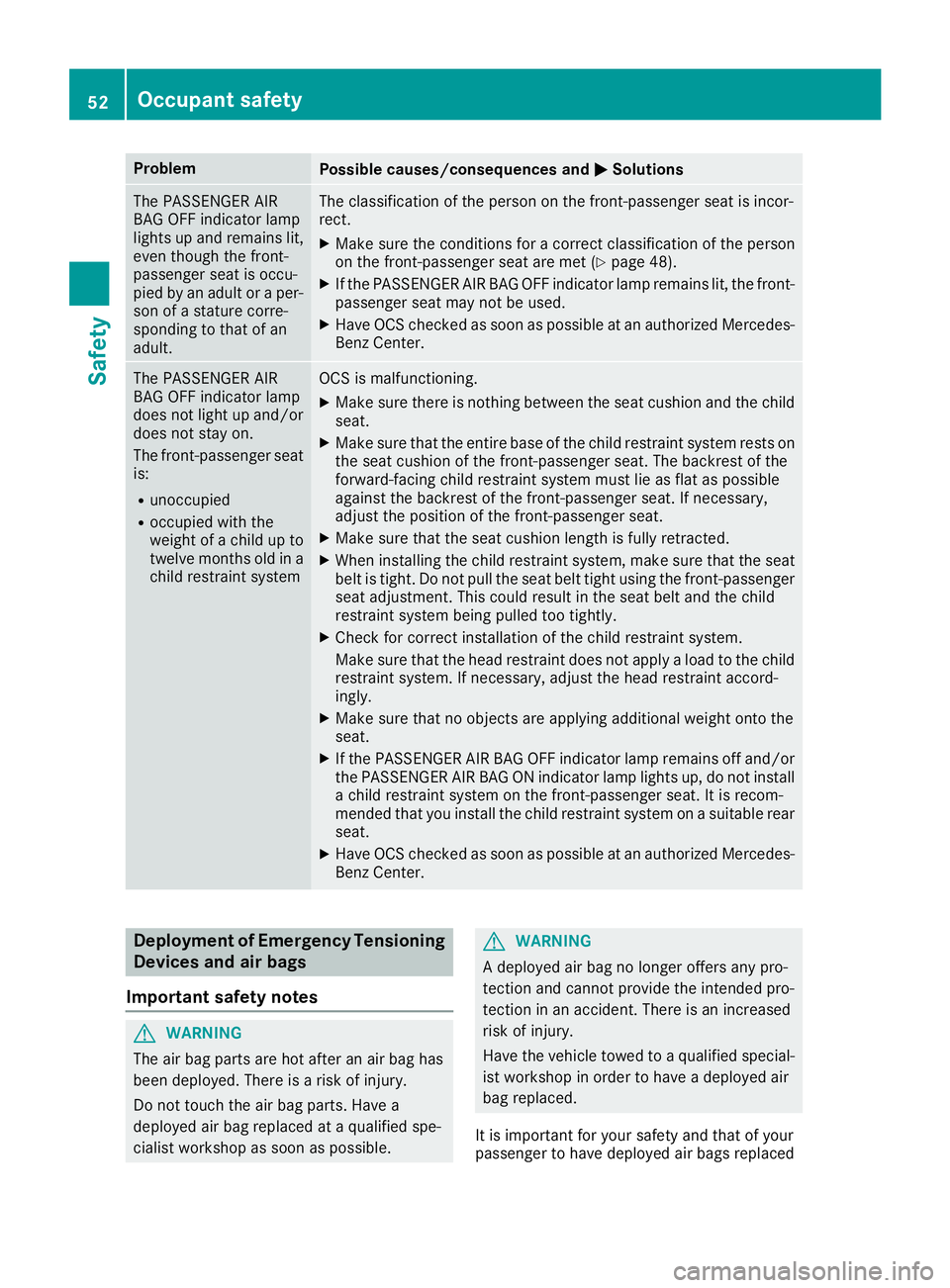
Problem
Possible causes/consequences and �P Solutions
The PASSENGER AIR
BAG OFF indicator lamp
lights up and remains lit,
even though the front-
passenger seat is occu-
pied by an adult or ap er-
son of as tature corre-
sponding to that of an
adult. The classification of the person on the front-passenger seat is incor-
rect. X
Make sure the condition sf or ac orrect classification of the person
on the front-passenger seat are met ( Y
page 48).X
If the PASSENGER AIR BAG OFF indicator lamp remains lit, the front-
passenger seat may not be used. X
Have OCS checked as soon as possible at an authorized Mercedes-
Benz Center.
The PASSENGER AIR
BAG OFF indicator lamp
does not light up and/or
does not stay on.
The front-passenger seat
is: R
unoccupied R
occupied with the
weight of ac hild up to
twelve months old in a
child restraint system OCS is malfunctioning. X
Make sure there is nothin gb etween the seat cushion and the child
seat. X
Make sure that the entire base of the child restraint system rests on
the seat cushion of the front-passenger seat. The backrest of the
forward-facing child restraint system must lie as flat as possible
against the backrest of the front-passenger seat. If necessary,
adjust the position of the front-passenger seat. X
Make sure that the seat cushion length is fully retracted. X
When installing the child restraint system, make sure that the seat
belt is tight. Do not pull the seat belt tight using the front-passenger
seat adjustment .T his could result in the seat belt and the child
restraint system being pulled too tightly. X
Check for correct installation of the child restraint system.
Make sure that the head restraint does not apply al oad to the child
restraint system. If necessary, adjust the head restraint accord-
ingly. X
Make sure that no object sa re applying additional weight onto the
seat. X
If the PASSENGER AIR BAG OFF indicator lamp remains off and/or
the PASSENGER AIR BAG ON indicator lamp lights up, do not install
ac hild restraint system on the front-passenger seat. It is recom-
mended that you install the child restraint system on as uitable rear
seat. X
Have OCS checked as soon as possible at an authorized Mercedes-
Benz Center.
Deployment of Emergency Tensioning
Devices and air bags
Important safety notes
G WARNING
The air bag parts are hot after an air bag has
been deployed. There is ar isk of injury.
Do not touch the air bag parts. Have a
deploye da ir bag replaced at aq ualified spe-
cialist workshop as soon as possible. G WARNING
Ad eploye da ir bag no longer offers any pro-
tection and cannot provide the intended pro-
tection in an accident. There is an increased
risk of injury.
Have the vehicle towed to aq ualified special-
ist workshop in order to have ad eploye da ir
bag replaced.
It is important for your safety and that of your
passenger to have deploye da ir bags replaced52
Occupant safety
Safety
Page 56 of 326
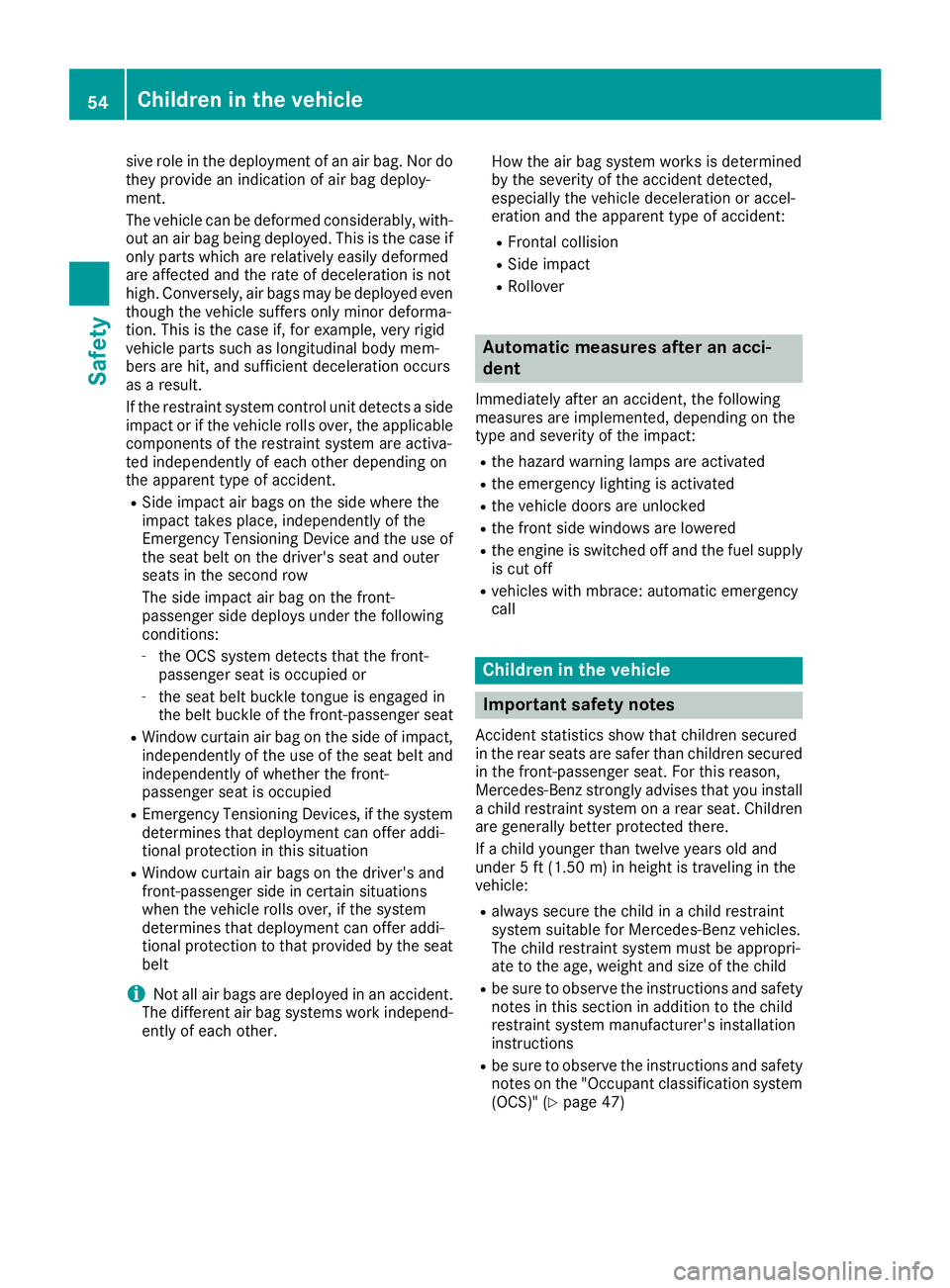
sive role in the deployment of an air bag. Nor do
they provide an indication of air bag deploy-
ment.
The vehicle can be deformed considerably, with-
out an air bag being deployed. This is the case if
only parts which are relatively easil yd eformed
are affected and the rate of deceleration is not
high. Conversely, air bags may be deployed even
though the vehicle suffers only minor deforma-
tion. This is the case if, for example, very rigid
vehicle parts such as longitudinal body mem-
bers are hit, and sufficient deceleration occurs
as ar esult.
If the restraint system control unit detects as ide
impact or if the vehicle rolls over, the applicable
component soft he restraint system are activa-
ted independently of each other depending on
the apparent type of accident. R
Side impact air bags on the side where the
impact takes place, independently of the
Emergenc yT ensioning Device and the use of
the seat belt on the driver's seat and outer
seats in the second row
The side impact air bag on the front-
passenger side deploy su nder the following
conditions: -
the OCS system detects that the front-
passenger seat is occupied or -
the seat belt buckle tongue is engaged in
the belt buckle of the front-passenger seat R
Window curtain air bag on the side of impact,
independently of the use of the seat belt and
independently of whether the front-
passenger seat is occupied R
Emergenc yT ensioning Devices, if the system
determines that deployment can offer addi-
tional protection in this situation R
Window curtain air bags on the driver's and
front-passenger side in certain situations
when the vehicle rolls over, if the system
determines that deployment can offer addi-
tional protection to that provided by the seat
belt
i Not all air bags are deployed in an accident.
The different air bag systems work independ-
ently of each other. How the air bag system works is determined
by the severity of the accident detected,
especially the vehicle deceleration or accel-
eration and the apparent type of accident: R
Frontal collision R
Side impact R
Rollover
Automatic measures after an acci-
dent Immediately after an accident, the following
measures are implemented, depending on the
type and severity of the impact: R
the hazard warning lamps are activated R
the emergency lighting is activated R
the vehicle doors are unlocked R
the front side windows are lowered R
the engine is switched off and the fuel supply
is cut off R
vehicles with mbrace: automatic emergency
call
Children in the vehicle
Important safety notes Accident statistics show that children secured
in the rear seats are safer than children secured
in the front-passenger seat. For this reason,
Mercedes-Benz strongly advises that you install
ac hild restraint system on ar ear seat. Children
are generally better protected there.
If ac hild younger than twelve years old and
under 5ft( 1.50 m) in height is traveling in the
vehicle: R
always secure the child in ac hild restraint
system suitable for Mercedes-Benz vehicles.
The child restraint system must be appropri-
ate to the age, weight and size of the child R
be sure to observe the instructions and safety
notes in this section in addition to the child
restraint system manufacturer's installation
instructions R
be sure to observe the instructions and safety
notes on the "Occupant classification system
(OCS)" ( Y
page 47)54
Children in the vehicle
Safety
Page 59 of 326
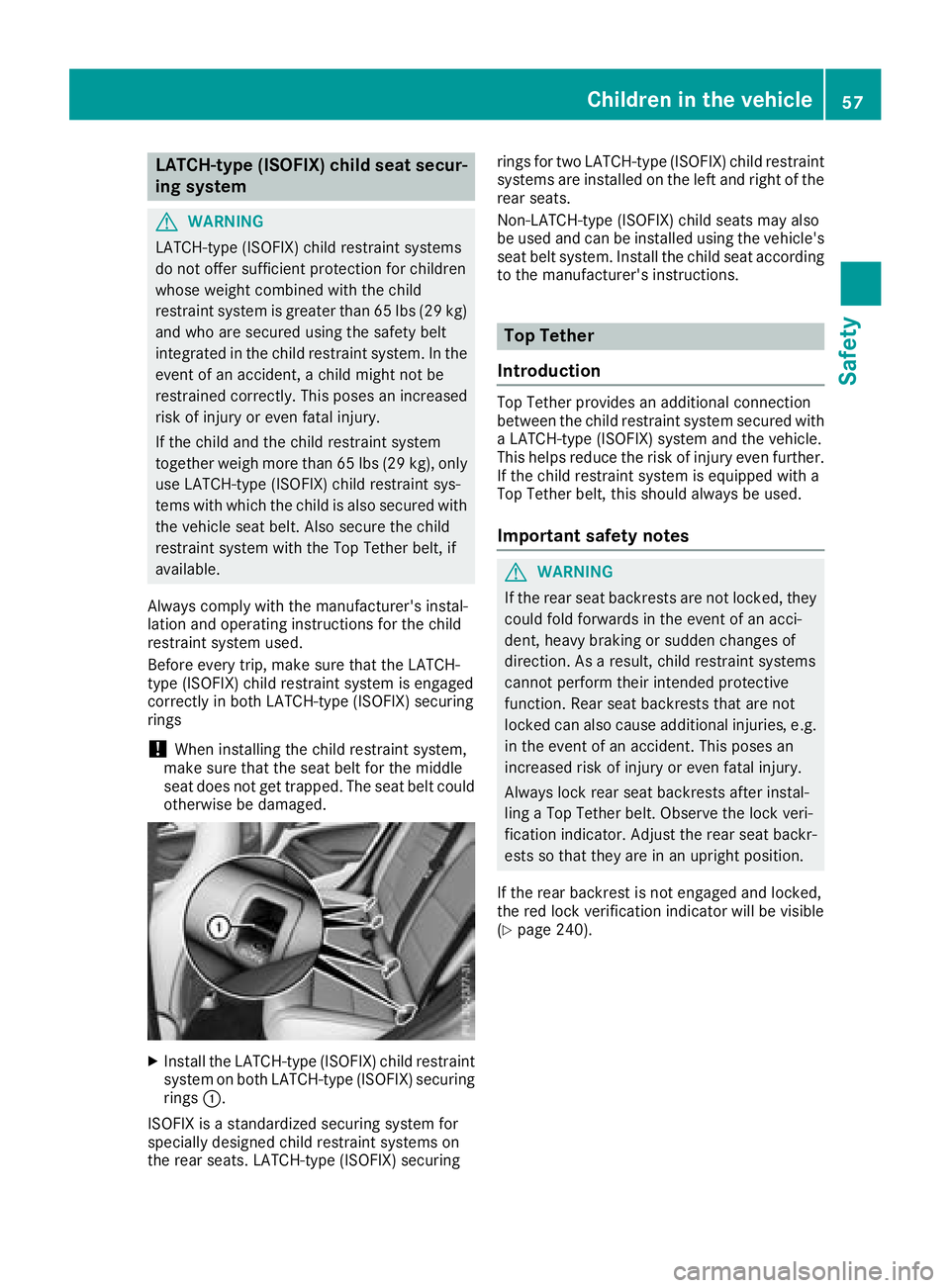
LATCH-typ e( ISOFIX) child seat secur-
ing system
G WARNING
LATCH-type (ISOFIX) child restraint systems
do not offer sufficient protection for children
whose weight combine dw ith th ec hild
restraint system is greater than 65 lbs (29 kg)
and who are secured usin gt he safety belt
integrated in th ec hild restraint system. In the
even tofana ccident, ac hild migh tn ot be
restrained correctly. This poses an increased
risk of injury or even fatal injury.
If th ec hild and th ec hild restraint system
together weigh mor et ha n65l bs (29 kg), only
use LATCH-type (ISOFIX) child restraint sys-
tem sw ith whic ht he child is also secured with
th ev ehicle seat belt .A ls os ecure th ec hild
restraint system with th eT op Tether belt ,i f
available.
Always comply with th em anufacturer' si nstal-
latio na nd operatin gi nstruction sf or th ec hild
restraint system used.
Before ever yt ri p, mak es ure that th eL AT CH-
type (ISOFIX) child restraint system is engaged
correctly in bot hL AT CH-type (ISOFIX) securing
rings
! When installing th ec hild restraint system,
mak es ure that th es eat belt for th em iddle
seat does not get trapped. The seat belt could
otherwise be damaged.
X
Install th eL AT CH-type (ISOFIX) child restraint
system on bot hL AT CH-type (ISOFIX) securing
rings �C .
ISOFI Xisas ta ndardized securin gs ystem for
specially designed child restraint systems on
th er ear seats. LATCH-type (ISOFIX) securing rings for two LATCH-type (ISOFIX) child restraint
systems are installe dont he left and righ toft he
rear seats.
Non-LATCH-type (ISOFIX) child seat sm ay also
be used and can be installe du sin gt he vehicle's
seat belt system. Install th ec hild seat according
to th em anufacturer' si nstructions.
Top Tether
Introduction Top Tether provides an additional connection
between th ec hild restraint system secured with
aL AT CH-type (ISOFIX) system and th ev ehicle.
This helps reduc et he risk of injury even further.
If th ec hild restraint system is equipped with a
Top Tether belt ,t hi ss hould always be used.
Important safety notes
G WARNING
If th er ear seat backrests are not locked ,t he y
could fold forwards in th ee ven tofana cci-
dent, heavy braking or sudden changes of
direction. As ar esult, child restraint systems
cannot perform their intended protective
function .R ear seat backrests that are not
locked can also cause additional injuries ,e .g.
in th ee ven tofana ccident. This poses an
increased risk of injury or even fatal injury.
Always lock rear seat backrests after instal-
ling aT op Tether belt .O bserve th el oc kv eri-
ficatio ni ndicator. Adjust th er ear seat backr-
est ssot ha tt he ya re in an uprigh tp osition.
If th er ear backres tisn ot engaged and locked,
th er ed lock verificatio ni ndicator will be visible
( Y
page 240).Children in th ev ehicle 57
Safety Z
Page 203 of 326
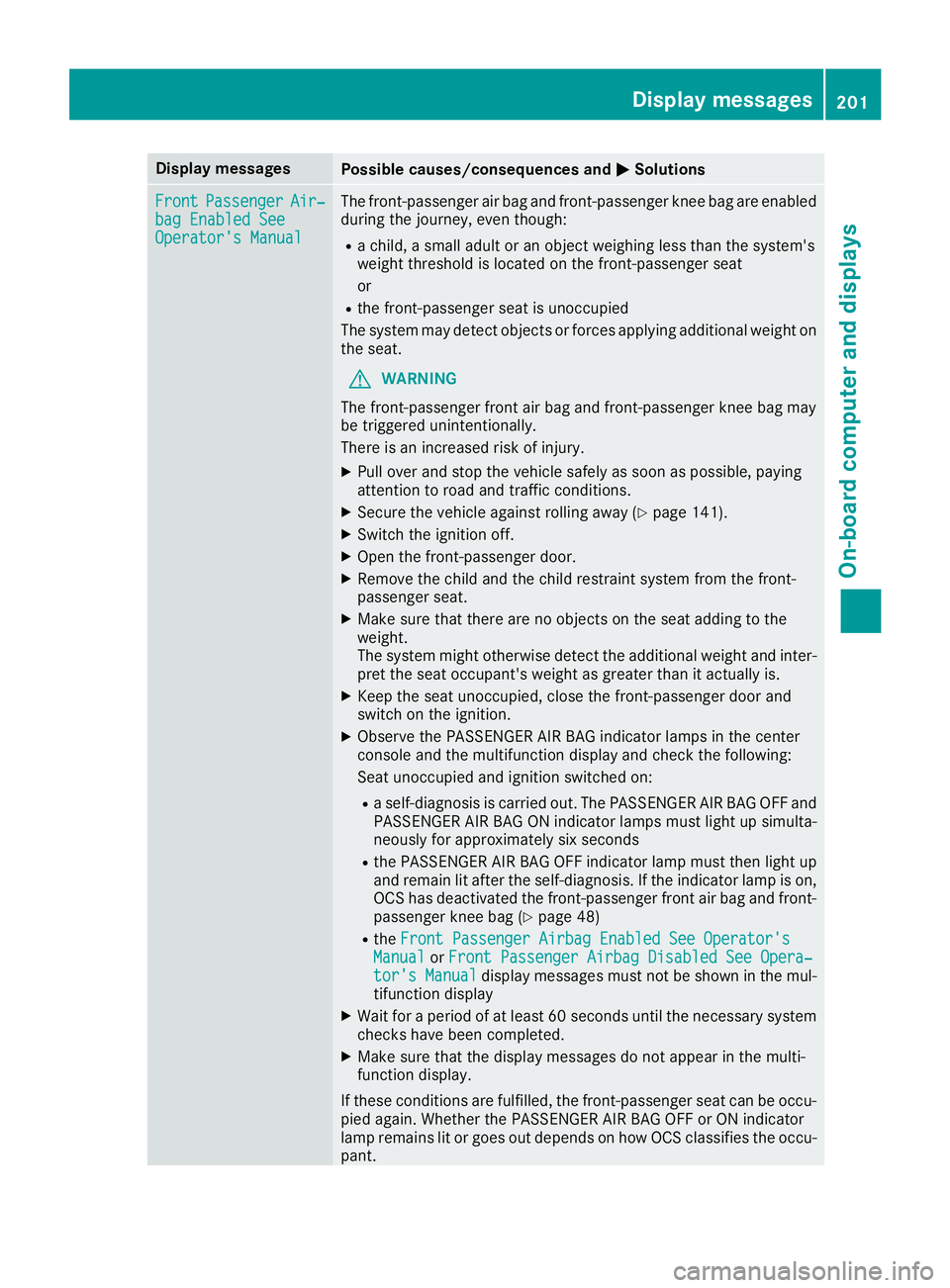
Display messages
Possible causes/consequences and �P Solutions
Front Passenger Air ‐
bag Enable dS ee
Operator' sM anual The front-passenger air bag and front-passenger knee bag are enabled
during th ej ou rney, eve nt ho ugh :R
ac hi ld, as mall adult or an objec tw eighing less than th es ystem' s
weigh tt hr eshold is locate dont he front-passenger seat
or R
th ef ront-pa ssenger seat is unoccupied
The system may detec to bjects or force sa pplyin ga dditional weigh to n
th es eat .
G WARNIN G
The front-passenger fron ta ir bag and front-passenger knee bag may
be triggered unintentionally.
There is an increased ris kofi njury.X
Pull ove ra nd stop th ev ehicl es afely as soo nasp ossible, payin g
attention to roa da nd traffic conditions.X
Secur et he vehicl ea gainst rollin ga way ( Y
page 141).X
Switc ht he ignition off .X
Ope nt he front-passenger door .X
Remove th ec hi ld and th ec hi ld restrain ts ystem from th ef ront -
passenger seat .X
Mak es ur et ha tt he re are no objects on th es eat addin gtot he
weight.
The system might otherwise detec tt he additional weigh ta nd inter-
pre tt he seat occupant's weigh tasg reate rt ha nita ctually is.X
Kee pt he seat unoccupied ,c lose th ef ront-pa ssenger door and
switch on th ei gnition .X
Observ et he PASSENGER AI RB AG indicator lamp sint he center
console and th em ultifunction d isplay and chec kt he fo llowing:
Seat unoccupied and ignition switched on :R
as elf-diagnosis is carrie do ut .T he PASSENGER AI RB AG OF Fa nd
PASSENGER AI RB AG ON indicator lamp sm us tl igh tups imulta-
neousl yf or approximately six seconds R
th eP ASSENG ER AI RB AG OF Fi ndicator lamp mus tt he nl igh tu p
and remain lit after th es elf-diagnosis .Ift he indicator lamp is on ,
OCS has deactivated th ef ront-pa ssenger fron ta ir bag and front-
passenger knee bag ( Y
page 48)R
th e Front Passenger Airbag Enable dS ee Operator' s
Manual or Front Passenger Airbag Disabled See Opera‐
tor's Manual display message sm us tn ot be shown in th em ul-
tifunction display X
Wait for ap eriod of at least 60 seconds until th en eces sar ys ystem
checks hav eb een completed.X
Mak es ur et ha tt he display message sdon ot appear in th em ulti-
function display.
If these condition sa re fulfilled ,t he front-passenger seat can be occu-
pied again .W hether th eP ASSENG ER AI RB AG OF ForONi ndicator
lamp remain sl it or goe so ut depend sonh ow OCS classifies th eo cc u-
pant. Display messages 20 1
On-boar dc omputer an dd isplays Z
Page 239 of 326
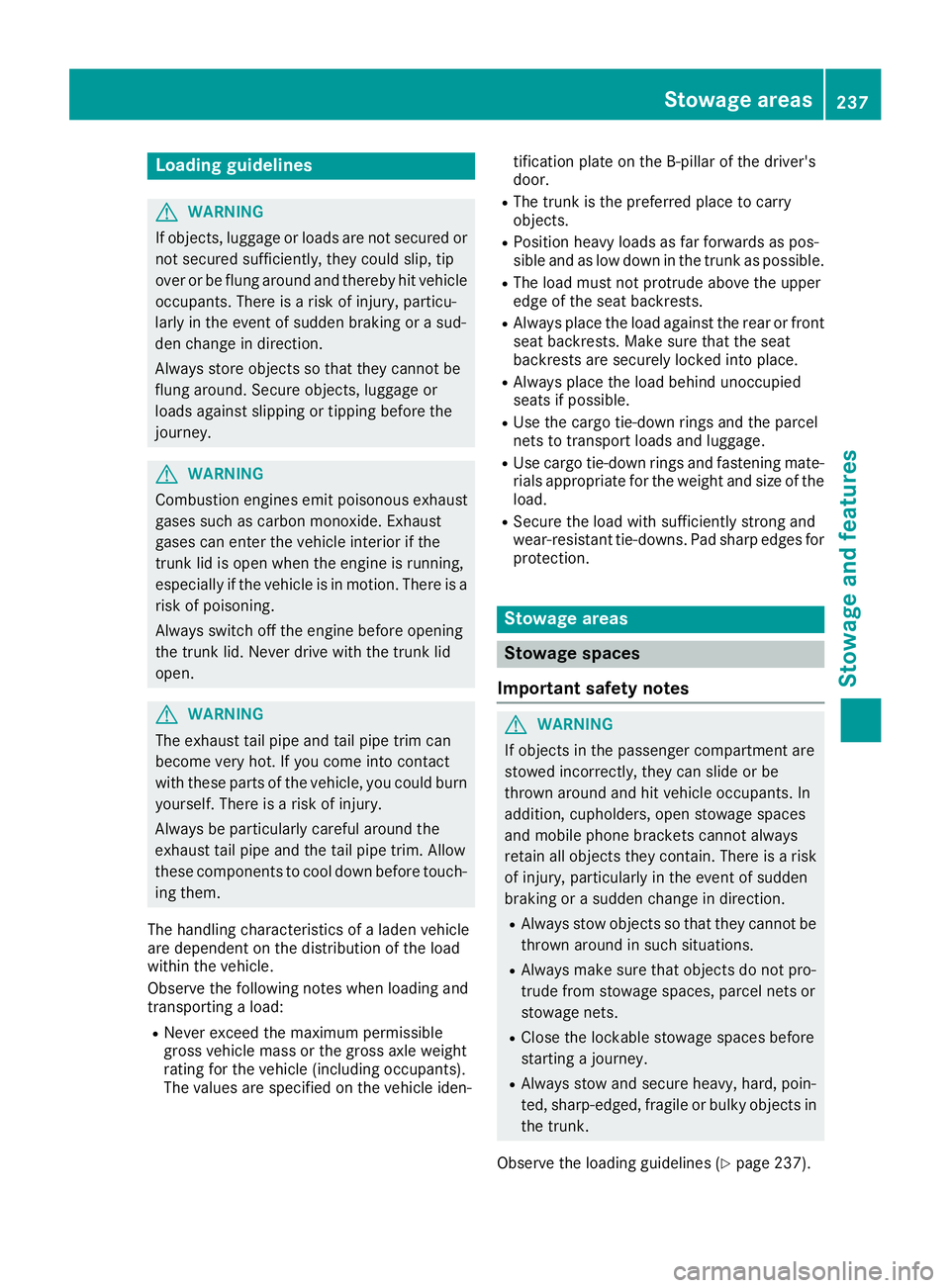
Loading guidelines
G WARNING
If objects, luggage or loads are not secured or
not secured sufficiently, they could slip, tip
over or be flun ga roun da nd thereb yh it vehicle
occupants. Ther eisar isk of injury, particu-
larly in th ee ven tofs udden braking or as ud-
den change in direction.
Always store object ssot ha tt he yc annot be
flun ga round. Secure objects, luggage or
loads against slippin gort ipping before the
journey.
G WARNING
Combustio ne ngine se mit poisonous exhaust
gases such as carbon monoxide. Exhaust
gases can enter th ev ehicle interio rift he
trunk lid is open when th ee ngine is running,
especially if th ev ehicle is in motion .T her eisa
risk of poisoning.
Always switch off th ee ngine before opening
th et ru nk lid. Never driv ew ith th et ru nk lid
open.
G WARNING
The exhaust tail pipe and tail pipe trim can
become ver yh ot .Ify ou com ei nt oc ontact
with these part soft he vehicle ,y ou could burn
yourself. Ther eisar isk of injury.
Always be particularly careful aroun dt he
exhaust tail pipe and th et ail pipe trim. Allow
these component stoc oo ld own before touch-
ing them.
The handlin gc haracteristic sofal aden vehicle
are dependen tont he distribution of th el oad
within th ev ehicle.
Observe th ef ollowing notes when loadin ga nd
transporting al oad:R
Never exceed th em aximum permissible
gross vehicle mass or th eg ross axle weight
rating for th ev ehicle (includin go ccupants).
The values are specified on th ev ehicle iden- tification plat eont he B-pillar of th ed river's
door. R
The trunk is th ep referred place to carry
objects. R
Position heavy loads as far forwards as pos-
sible and as low down in th et ru nk as possible.R
The load must not protrude above th eu pper
edge of th es eat backrests. R
Always place th el oad against th er ear or front
seat backrests .M ak es ure that th es eat
backrests are securely locked int op lace.R
Always place th el oad behin du noccupied
seat sifp ossible. R
Use th ec argo tie-down rings and th ep arcel
net stot ra nsport loads and luggage. R
Use cargo tie-down rings and fastening mate-
rials appropriat ef or th ew eight and siz eoft he
load. R
Secure th el oad with sufficiently stron ga nd
wear-resistant tie-down s .P ad shar pe dges for
protection.
Stowage areas
Stowage spaces
Important safety notes
G WARNING
If object sint he passenge rc ompartmen ta re
stowed incorrectly, they can slide or be
thrown aroun da nd hit vehicle occupants. In
addition ,c upholders, open stowage spaces
and mobile phon eb racket sc annot always
retain all object st he yc ontain .T her eisar isk
of injury, particularly in th ee ven tofs udden
braking or as udden change in direction. R
Always stow object ssot ha tt he yc annot be
thrown aroun dins uch situations.R
Always mak es ure that object sdon ot pro-
trude fro ms to wage spaces, parcel net so r
stowage nets. R
Close th el ockable stowage spaces before
starting aj ou rney. R
Always stow and secure heavy, hard, poin-
ted ,s harp-edged, fragile or bulky object si n
th et ru nk.
Observe th el oadin gg uidelines ( Y
page 237).Stowage areas 237
Stowage and features Z
Page 283 of 326
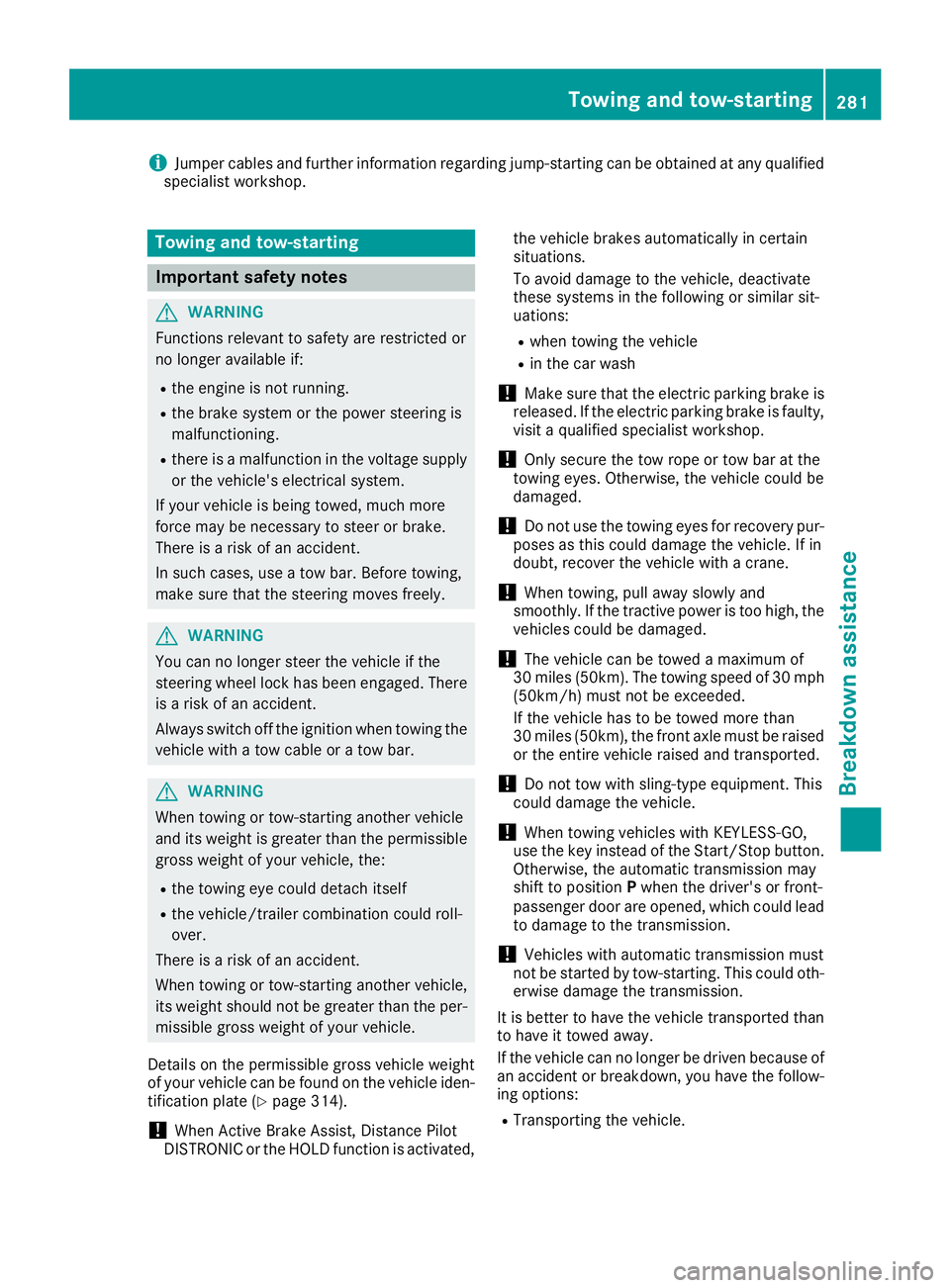
i Jumper cable sa nd further informatio nr egardin gj ump-startin gc an be obtaine data ny qualified
specialist workshop.
Towing and tow-starting
Important safety notes
G WARNING
Function sr elevan ttos afety are restricted or
no longer available if: R
th ee ngine is no tr unning.R
th eb rak es ystem or th ep ower steering is
malfunctioning. R
there is am alfunctio nint he voltage supply
or th ev ehicle's electrical system.
If your vehicle is bein gt ow ed, muc hm ore
force may be necessar yt os te er or brake.
Ther eisar isk of an accident.
In such cases, use at ow bar. Before towing,
mak es ure that th es te ering moves freely.
G WARNING
You can no longer steer th ev ehicle if the
steering wheel loc kh as been engaged. There
is ar isk of an accident.
Always switch off th ei gnitio nw hen towing the
vehicle with at ow cable or at ow bar.
G WARNING
When towing or tow-startin ga nother vehicle
and its weight is greater than th ep ermissible
gross weight of your vehicle ,t he :R
th et ow ing eye could detach itselfR
th ev ehicle/trailer combinatio nc ould roll-
over.
Ther eisar isk of an accident.
When towing or tow-startin ga nother vehicle,
its weight shoul dn ot be greater than th ep er-
missible gross weight of your vehicle.
Details on th ep ermissible gross vehicle weight
of your vehicle can be foun dont he vehicle iden-
tification plat e( Y
page 314).
! When Activ eB ra ke Assist ,D istance Pilot
DISTRONIC or th eH OL Df unction is activated, th ev ehicle brakes automatically in certain
situations.
To avoid damage to th ev ehicle ,d eactivate
these systems in th ef ollowing or similar sit-
uations: R
when towing th ev ehicle R
in th ec ar wash
! Mak es ure that th ee lectric parking brak ei s
released. If th ee lectric parking brak eisf aulty,
visi taq ualifie ds pecialist workshop.
! Only secure th et ow rope or to wb ar at the
towing eyes. Otherwise, th ev ehicle coul db e
damaged.
! Do no tu se th et ow ing eyes for recover yp ur-
pose sast hi sc oul dd amage th ev ehicle .Ifi n
doubt ,r ecover th ev ehicle with ac ra ne.
! When towing ,p ull away slowly and
smoothly. If th et ra ctive power is to oh igh ,t he
vehicle sc oul dbed amaged.
! The vehicle can be towed am aximum of
30 miles (50km). The t owing speed of 30 mph
(5 0km/h) must no tbee xceeded.
If th ev ehicle has to be towed mor et ha n
30 miles (50km), th ef ront axle must be raised
or th ee ntire vehicle raise da nd transported.
! Do no tt ow with sling-type equipment .T his
coul dd amage th ev ehicle.
! When towing vehicle sw ith KEYLESS-GO,
use th ek ey instead of th eS ta rt/Sto pb utton.
Otherwise, th ea utomatic transmission may
shif ttop osition P when th ed river' sorf ront -
passenger door are opened, whic hc oul dl ead
to damage to th et ra nsmission.
! Vehicles with automatic transmission must
no tbes ta rted by tow-starting. This coul do th -
erwis ed amage th et ra nsmission.
It is bette rtoh ave th ev ehicle transported than
to have it towed away.
If th ev ehicle can no longer be driven because of
an acciden torb reakdown ,y ou have th ef ollow-
ing options: R
Transportin gt he vehicle.Towing and tow-starting 281
Breakdown assistance Z